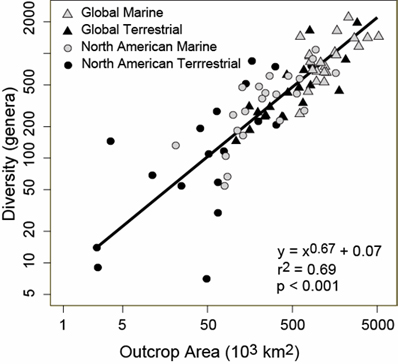Influence of Outcrop Area on Measures of Phanerozoic Diversity
Plotting the area of outcrop of sedimentary rocks against the recovered diversity of the same time interval reveals a strong correlation, demonstrating that the greater the area available for sampling, the more fossils and hence taxa are recovered. Even after standardizing for sampling intensity, the correlation persists, suggesting that the areal distribution of fossils needs to be taken into account in studies of Phanerozoic diversity. See papers by Wall and others (2009, 2011).

Student
- Patrick Wall (Ph.D.) “Incorporating spatial datasets into paleontology: Effects on estimates of diversity, origination, and extinction.”
Publications
(*student author)
Wall*, P.D., Ivany, L.C., and Wilkinson, B.H. (2011) Impact of outcrop area on estimates of Phanerozoic terrestrial biodiversity trends. In A. McGowan and A.B. Smith (Eds.) Comparing the Geological and Fossil Records: Implications for Biodiversity Studies. Geological Society of London, Special Publication 358, p. 53-62.
Wall, Patrick D.*, Ivany, Linda C., and Wilkinson, Bruce H. (2009) Revisiting Raup: Exploring the influence of outcrop area on diversity in light of modern sample-standardization techniques. Paleobiology, v. 35, p. 149-170.
Alroy, John, and the NCEAS Marine Invertebrate Working Group (2008) Phanerozoic trends in the global diversity of marine invertebrates. Science, v. 321, p. 97-100.
Walker, Luke J., Wilkinson, Bruce H., and Ivany, Linda C. (2002) Continental drift and Phanerozoic carbonate accumulation in shallow shelf and deep marine settings. Journal of Geology 110, pp 75-87.
Alroy, John, and the NCEAS Phanerozoic Diversity Working Group (2001) Effects of sampling standardization on estimates of Phanerozoic marine diversification. Proceedings of the National Academy of Sciences USA, 98(11), pp. 6261-6266.
